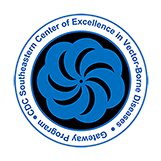Meet The Team
André Luis da Costa da Silva, PhD
Postdoctoral Fellow, Laboratory of Tropical Genetics Florida International University
 Supervisor: Matthew DeGennaro, PhD
Supervisor: Matthew DeGennaro, PhD
Project 1: Understanding vector ecology, arbovirus infectious rates & insecticide resistance to optimize mosquito control
Specific Aim 2: Determine how novel vector control tools can be used in conjunction with currently used methods to improve integrated vector control strategies for urban environments.
Dr. André Luis da Costa da Silva is a postdoctoral fellow at Florida International University (FIU) in the Laboratory of Tropical Genetics advised by Dr. Matthew DeGennaro. André became interested in biology as a high school student and pursued a bachelor’s degree at University of Mogi das Cruzes, São Paulo, Brazil. During an opportunity as an undergraduate researcher, he became interested in studying mosquitoes, specifically the population genetics of Aedes aegypti.
André soon graduated and began studies at the University of São Paulo for his PhD in the Institute of Biomedical sciences program Biology of Host-Pathogen Interactions. His graduate researcher focused on differential gene expression and identification of tissue-specific promoters in Ae. aegypti mosquitoes. André also studied transgenesis technology in mosquitoes. After his PhD, he completed a postdoctoral fellowship at University of São Paulo studying mosquito and virus interaction focusing on Ae. aegypti, Zika and Chikungunya. In an area of Brazil where Chikungunya was endemic they found that Ae. aegypti was the vector responsible for transmission, as well as complete lab infectious studies with Zika, and determining how the virus develops in laboratory strains of this mosquito.
In 2017 André joined the CDC Southeastern Center of Excellence in Vector Borne diseases continuing his research on Ae. aegypti. André is part of the center-based project to create Highly Attractive Biological Insecticide Traps (HABITraps). The goal of these mosquito traps is to lure more fed (gravid) female mosquitoes to the HABITraps than a trap without an attractant. They ran a series of studies and found that geosmin is a strong attractant for gravid-female mosquitoes. Geosmin is naturally produced by beetroot and extracts of this vegetable also proved to be a potent natural attractant. This study was published recently and can be found here. By developing traps that attract more gravid females they are able to remove eggs or females from the environment to suppress mosquito population as well as use the eggs these mosquitoes lay as field samples for genetics, genomics, insecticide resistance or behavioral studies.
In 2017 André joined the CDC Southeastern Center of Excellence in Vector Borne diseases continuing his research on Ae. aegypti. André is part of the center-based project to create Highly Attractive Biological Insecticide Traps (HABITraps). The goal of these mosquito traps is to lure more fed (gravid) female mosquitoes to the HABITraps than a trap without an attractant. They ran a series of studies and found that geosmin is a strong attractant for gravid-female mosquitoes. Geosmin is naturally produced by beetroot and extracts of this vegetable also proved to be a potent natural attractant. This study was published recently and can be found here. By developing traps that attract more gravid females they are able to remove eggs or females from the environment to suppress mosquito population as well as use the eggs these mosquitoes lay as field samples for genetics, genomics, insecticide resistance or behavioral studies.

Another study André is working on explores the behavioral differences of where female mosquitoes lay their eggs. In the lab, when presented with two same sites to lay their eggs female mosquitoes aggregate to one over the other. In the literature it has been shown that egg or larvae presence can signal other females to lay their eggs there, but André is finding that before there are even eggs or larvae in the lab environment the mosquitoes are cueing each other. If he is able to isolate how the mosquitoes signal each other, André may be able to use it to alter the behavior of the mosquitoes. Understanding the signals mosquitoes use to identify egg-laying sites researchers can develop better attractions and interfere with mosquito behavior to protect the public.


At FIU André teaches PCB4717: U02 1201 Urban mosquitoes: from their ecology to the modern methods of control. In this course students learn about mosquito biology, traditional and modern methods of control, transgenic mosquitoes, Wolbachia technology, and they are also faced with unique opportunities to spot mosquito habitat on campus or debate which modern method of mosquito control would be implemented in a hypothetical situation. His students also participate in an internship that is led by graduate student Helen Wagner (who we will feature in our next interview) and Dr. DeGennaro. The students are provided with CDC ovitraps and collect mosquito eggs weekly at their homes. Even as students are working remotely during the pandemic, they are able to continue the internship and create awareness in their families of mosquitoes in their backyard.
To continue following André’s research or learn more about his past work click the links below:
DeGennaro Lab Page
Follow André on Twitter
Google Scholar
ResearchGate
LinkedIn
Recent Publication:
Melo N, Wolff GH, Costa-da-Silva AL, Arribas R, Triana MF, Gugger M, Riffell JA, DeGennaro M, Stensmyr MC. (2020). Geosmin attracts Aedes aegypti mosquitoes to oviposition sites. Current Biology. Jan 6;30(1):127-134.e5. doi:10.1016/j.cub.2019.11.002.
In this video you can see female mosquitoes laying eggs also called oviposition.
Video by: André Luis da Costa da Silva


